Sally Lunn Bread
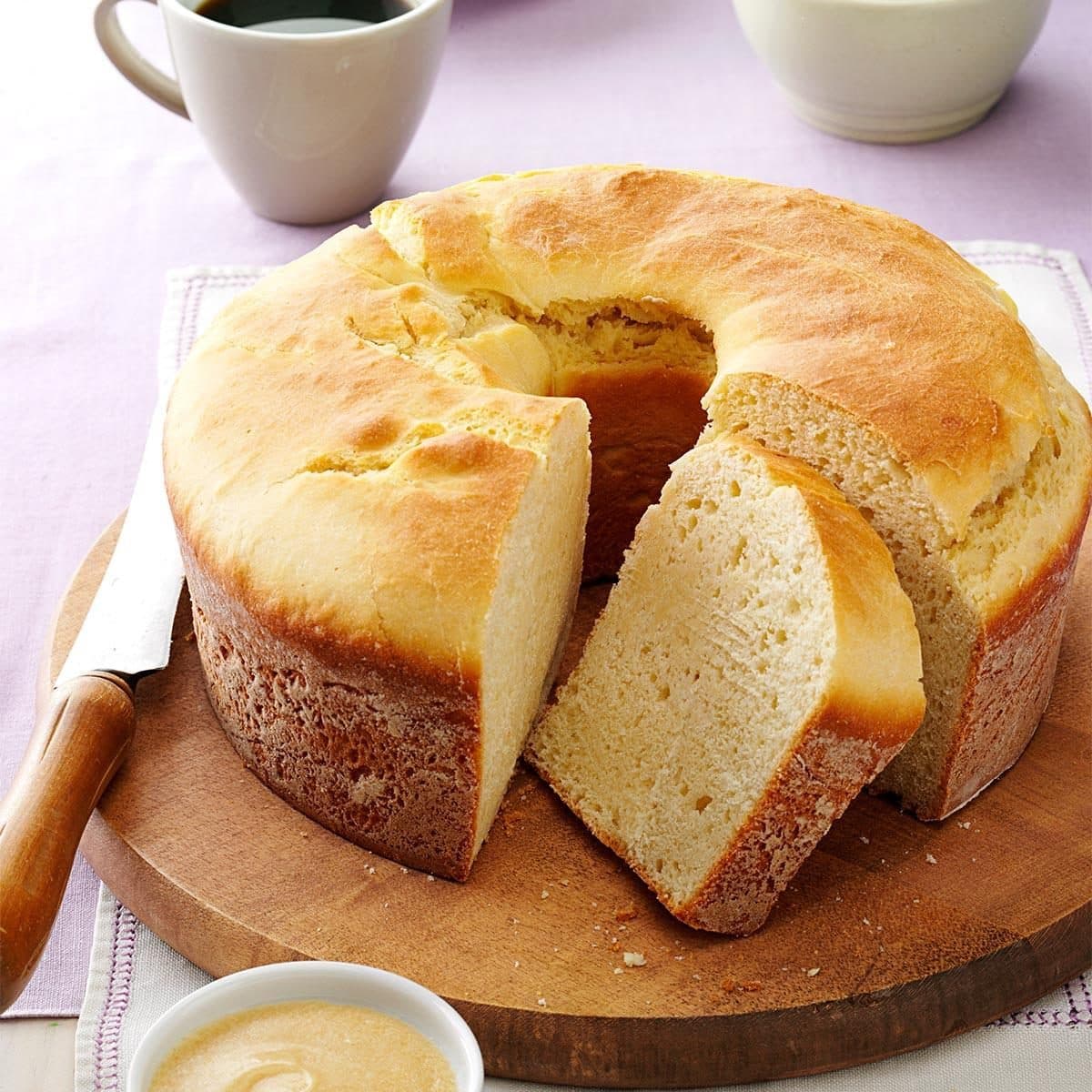
Get ready to fall head over heels for the most luxurious, buttery bread that’s been stealing hearts since the 1700s!
Sally Lunn bread isn’t your ordinary loaf – it’s a golden, tender masterpiece that sits perfectly between bread and cake, creating the most incredible texture that practically melts in your mouth.
This isn’t just baking; it’s creating pure comfort food magic that fills your entire kitchen with the most heavenly aroma of yeast, butter, and warmth.
The best part?
While it looks and tastes incredibly sophisticated, the no-knead method makes it surprisingly approachable for home bakers of any skill level.
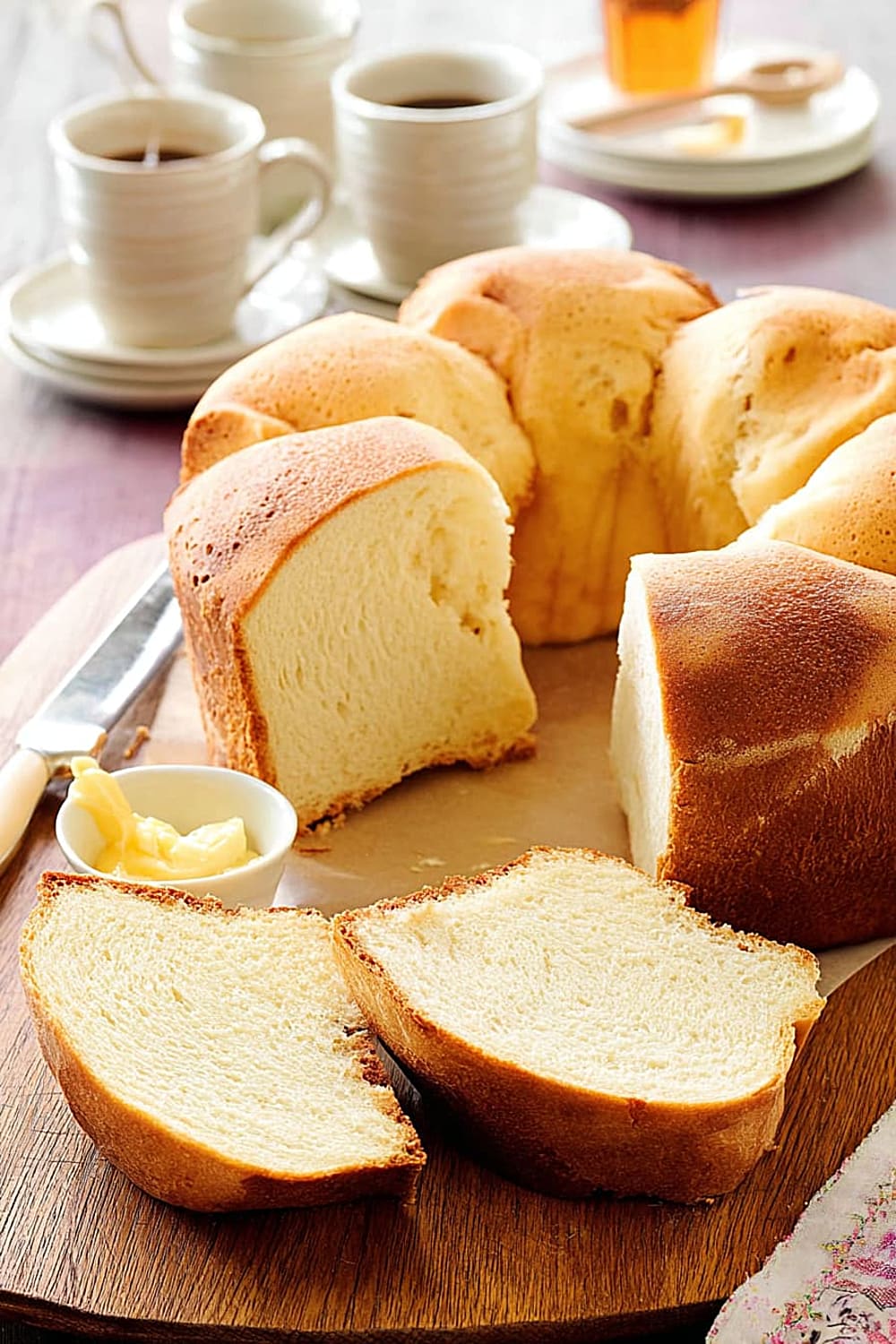
Picture pulling this gorgeous golden bread from your oven, its perfectly domed top glistening and begging to be sliced.
The moment you cut into it, you’ll discover the incredibly soft, almost cake-like crumb that makes Sally Lunn bread absolutely legendary.
Paired with that silky honey butter, each bite delivers layers of rich, buttery flavor with just the right touch of sweetness.
Whether you’re serving it for a special brunch, holiday gathering, or simply treating yourself to something extraordinary, this bread transforms any ordinary moment into something truly memorable.
The combination of warm milk, butter, and eggs creates a richness that’s absolutely irresistible.
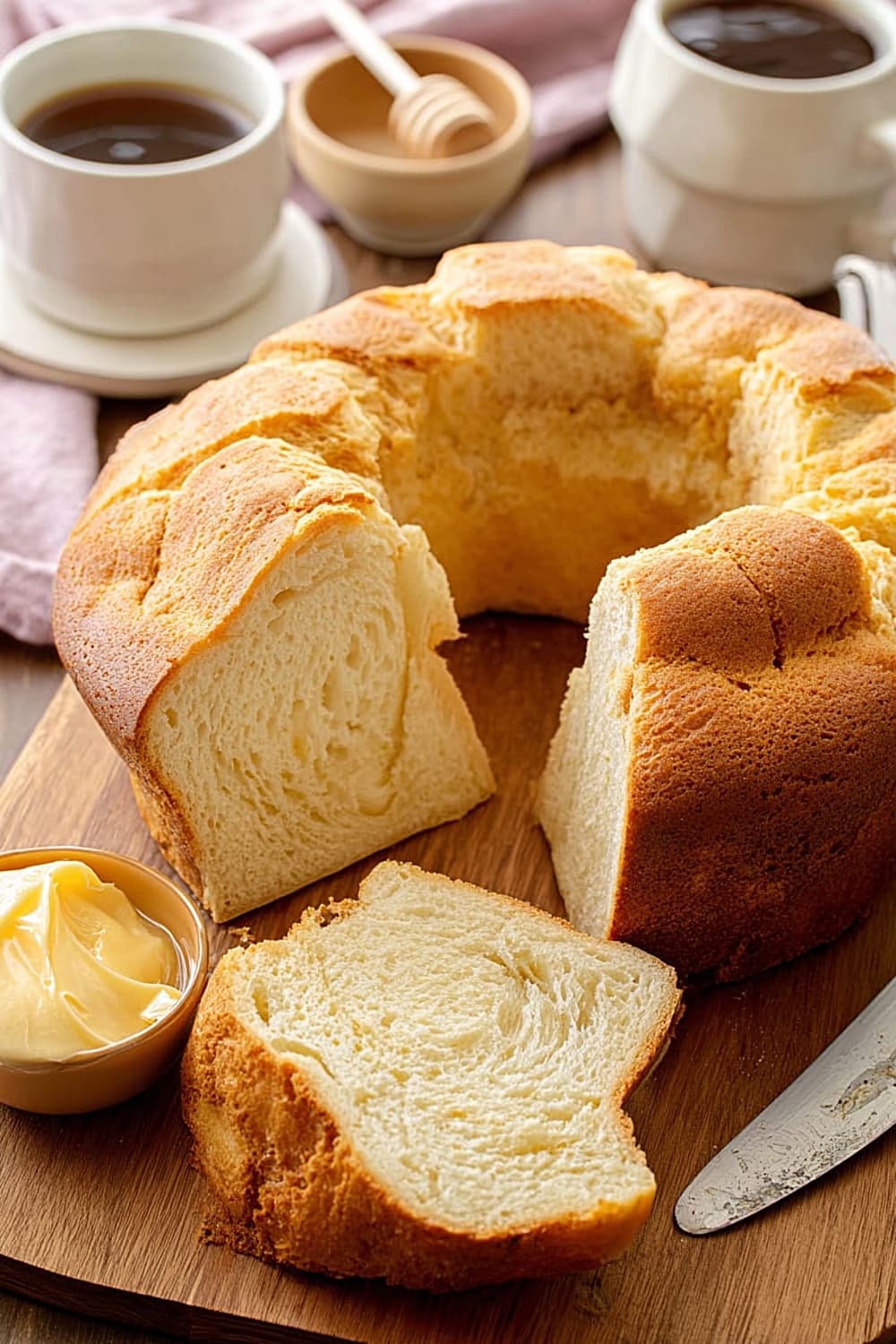
Ingredients
For the Sally Lunn Bread
- 1 package (1/4 ounce) active dry yeast
- 1 /2 cup warm water (110° to 115°F)
- 1 cup warm 2% milk (110° to 115°F)
- 1 /2 cup butter, softened
- 1 /4 cup sugar
- 2 teaspoons salt
- 3 large eggs, room temperature
- 5-1 /2 to 6 cups all-purpose flour
For the Honey Butter
- 1 /2 cup butter, softened
- 1 /2 cup honey
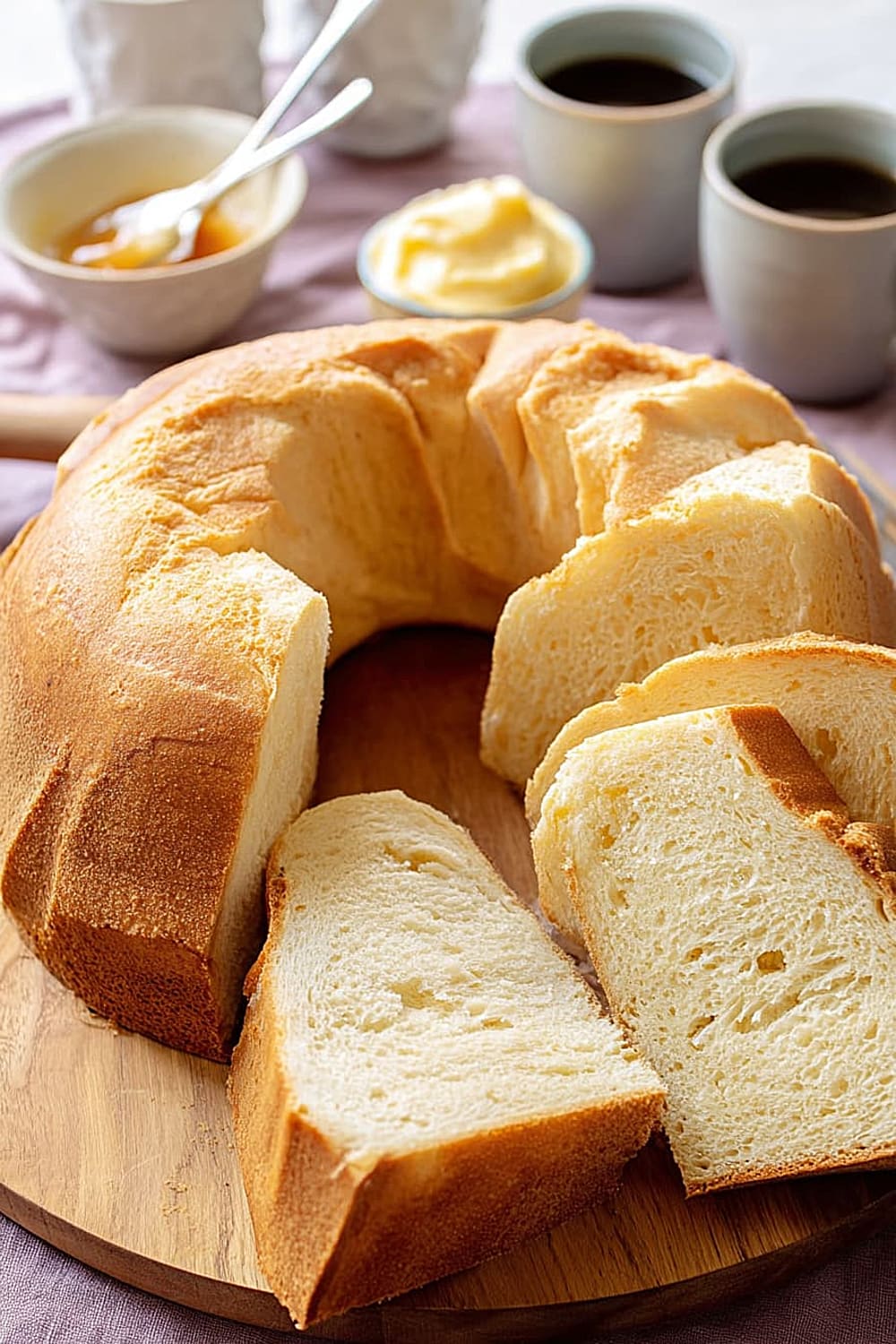
Instructions
Prepare the Yeast Mixture
- 1 In a large mixing bowl, dissolve 1 package active dry yeast in 1/2 cup warm water heated to 110° to 115°F (43° to 46°C). The water should feel comfortably warm on your wrist – too hot will kill the yeast, too cool won’t activate it properly. Let this mixture sit for 5 minutes until it becomes foamy, which confirms your yeast is active and ready to work its magic.
- 2 Add the 1 cup warm milk (also heated to 110° to 115°F), 1/2 cup softened butter, 1/4 cup sugar, 2 teaspoons salt, 3 room temperature eggs, and 3 cups flour to the yeast mixture. Using a stand mixer with the paddle attachment or beating vigorously by hand, mix until the batter is completely smooth and well combined, about 3-4 minutes.
Form the Soft Dough
- 3 Gradually stir in enough of the remaining 2-1/2 to 3 cups flour to form a soft, slightly sticky dough. The dough should be softer than typical bread dough – this is what creates Sally Lunn’s signature tender texture. You may not need all the flour, so add it gradually until the dough pulls away from the sides of the bowl but remains quite soft.
- 4 Here’s the beautiful part about Sally Lunn bread – do not knead! This no-knead method is what keeps the texture light and cake-like. Simply place the soft dough in a well-greased large bowl, turning it once to coat the top with grease to prevent a skin from forming.
First Rise
- 5 Cover the bowl with a clean kitchen towel or plastic wrap and let rise in a warm, draft-free place until doubled in size, about 1 hour. The dough should nearly double and feel light and airy when gently poked.
Shape and Second Rise
- 6 Gently stir the risen dough down with a wooden spoon to deflate it, being careful not to overwork it. Spoon the soft dough into a well-greased and floured 10-inch tube pan, spreading it evenly. The tube pan is essential for even baking and the classic Sally Lunn shape.
- 7 Cover the pan and let the dough rise again until doubled, about 1 hour. The dough should rise to nearly fill the pan and spring back slowly when lightly touched.
Bake to Golden Perfection
- 8 Preheat your oven to 400°F (200°C) during the last 15 minutes of the second rise. Bake for 25-30 minutes or until the top is golden brown and the bread sounds hollow when tapped. An instant-read thermometer should register 190°F (88°C) when inserted into the center.
- 9 Remove from the oven and let cool in the pan for 5 minutes, then turn out onto a wire rack to cool completely. This cooling step is crucial for the proper texture to develop.
Prepare the Honey Butter
- 10 While the bread cools, combine the 1/2 cup softened butter and 1/2 cup honey in a small bowl, beating until light and fluffy. This honey butter is the perfect complement to the rich bread and can be made ahead and stored covered at room temperature.
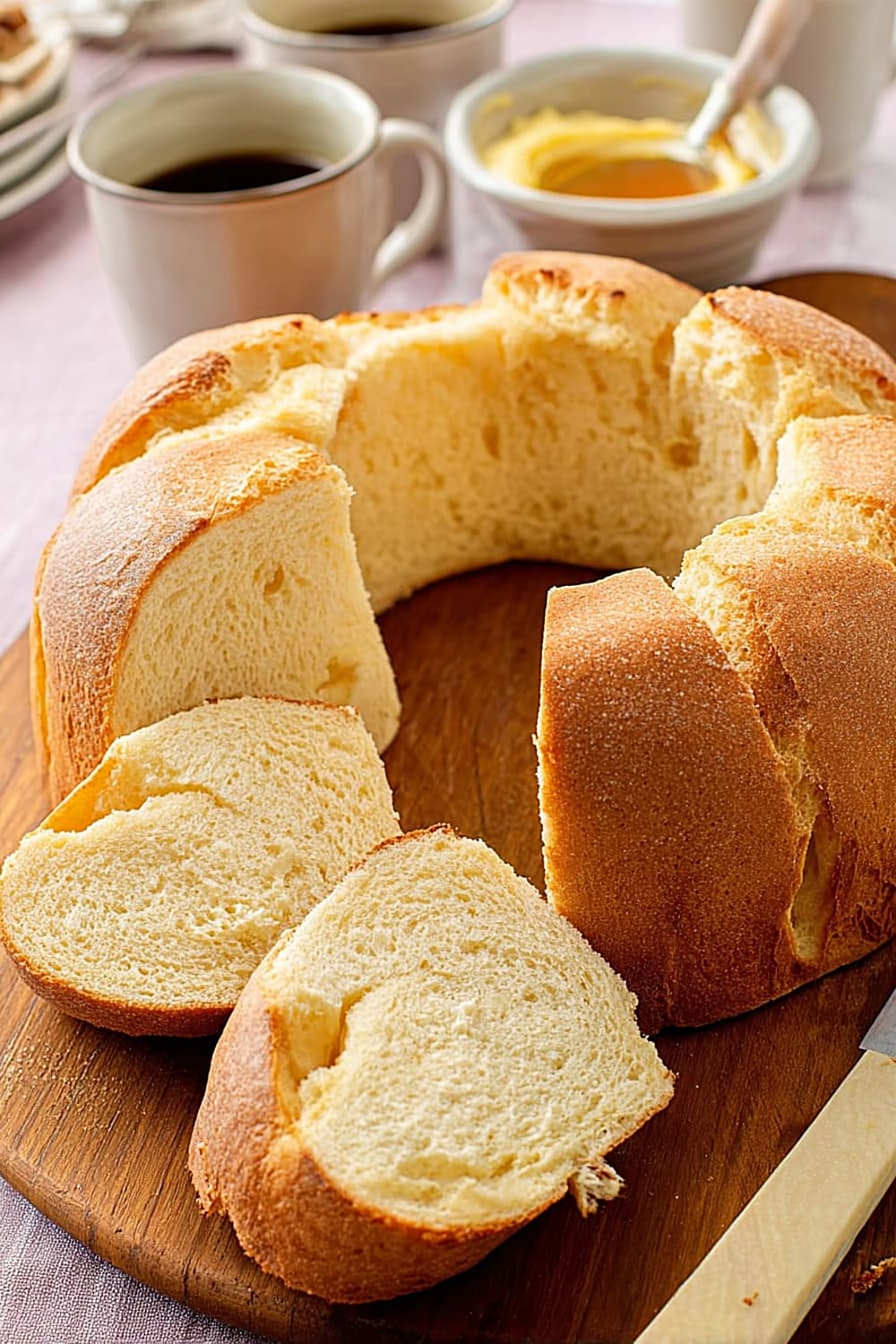
Recommended Equipment and Kitchen Tools
Recommended Tools (for best results):
- Stand mixer with paddle attachment – While you can mix by hand, a stand mixer makes combining the rich batter much easier and ensures even mixing without overworking the dough
- 10-inch tube pan – Essential for the classic Sally Lunn shape and even baking; the center tube helps heat distribute evenly through the thick dough
- Instant-read thermometer – Takes the guesswork out of checking water temperature for yeast activation and determining when the bread is perfectly baked
- Large mixing bowls – You’ll need generous space for the dough to double during rising
Helpful Upgrades:
- Kitchen scale – For more consistent results, especially when measuring flour, which can vary significantly when measured by volume
- Bench scraper – Makes transferring the soft, sticky dough much easier and helps keep your workspace clean
- Silicone spatula – Perfect for gently stirring down the risen dough without deflating it too much
Nice-to-Have Options:
- Proofing basket liner – If you want to proof the dough in a traditional basket before transferring to the tube pan for a more artisanal approach
- Digital kitchen timer – Helps keep track of multiple rising times, which are crucial for perfect texture
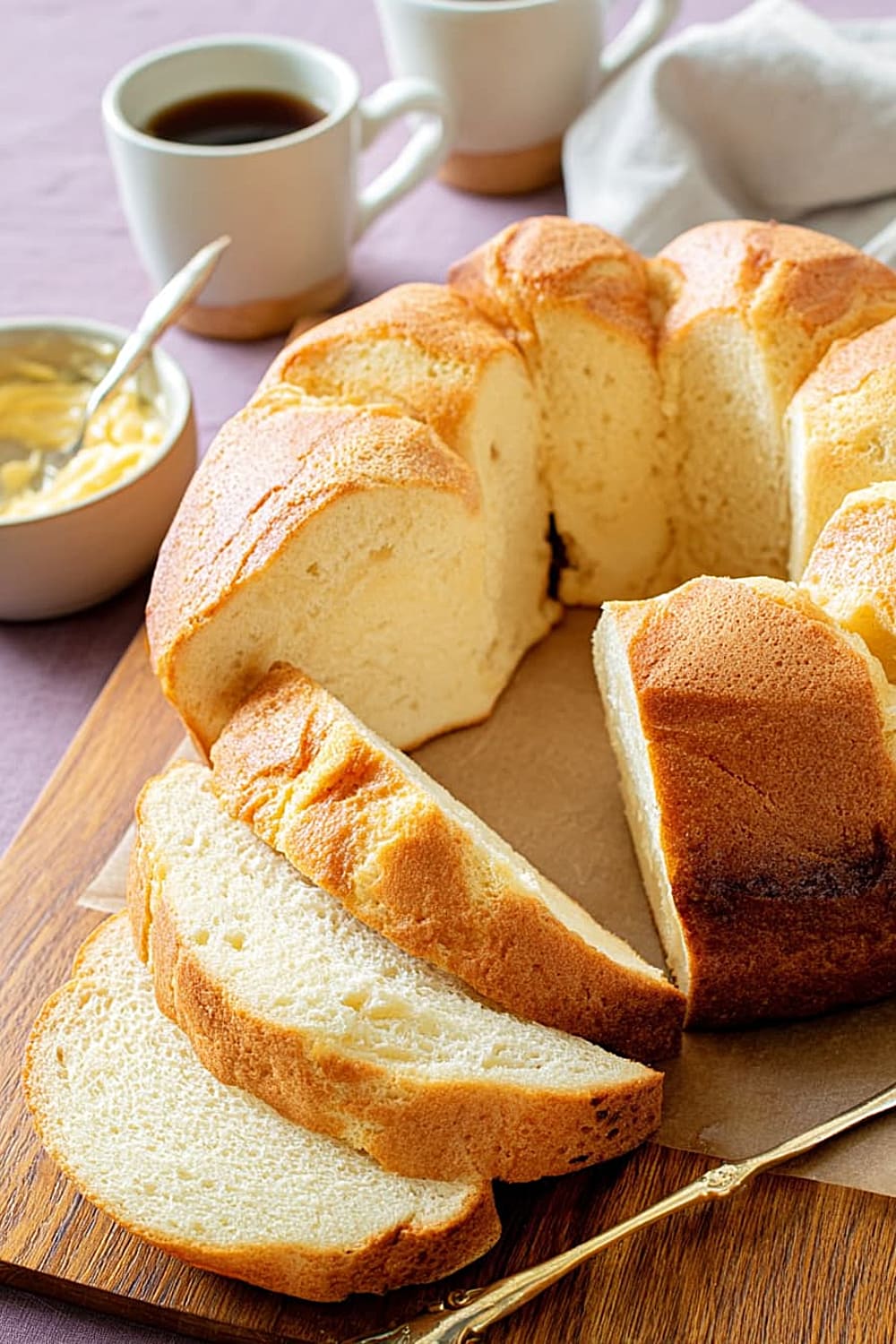
Recipe Variations and Dietary Modifications
Gluten-Free Adaptation:
- Replace the 5-1/2 to 6 cups all-purpose flour with a 1:1 gluten-free flour blend that contains xanthan gum
- Add an extra 1 teaspoon xanthan gum if your blend doesn’t include it
- Expect a slightly denser texture and reduce baking time by 5 minutes
- The dough will be stickier and may require greased hands for handling
Dairy-Free Modifications:
- Substitute the 1 cup warm milk with unsweetened almond milk or oat milk warmed to the same temperature
- Replace 1/2 cup butter in the bread with vegan butter or coconut oil (solid, not melted)
- For the honey butter, use vegan butter alternative
Vegan Version:
- Replace 3 large eggs with 3/4 cup unsweetened applesauce or 3 flax eggs (3 tablespoons ground flaxseed mixed with 9 tablespoons water, let sit 5 minutes)
- Use plant-based milk and vegan butter as noted above
- Rising times may be slightly longer due to different protein structure
Flavor Variations:
- Lemon Sally Lunn: Add 2 tablespoons fresh lemon zest and 1 teaspoon vanilla extract to the dough
- Orange Spice: Include 1 tablespoon orange zest and 1/2 teaspoon ground cardamom
- Herb-Infused: Add 2 tablespoons fresh chopped rosemary or thyme for a savory version
- Cinnamon Sugar: Swirl 2 tablespoons cinnamon sugar through the dough before the second rise
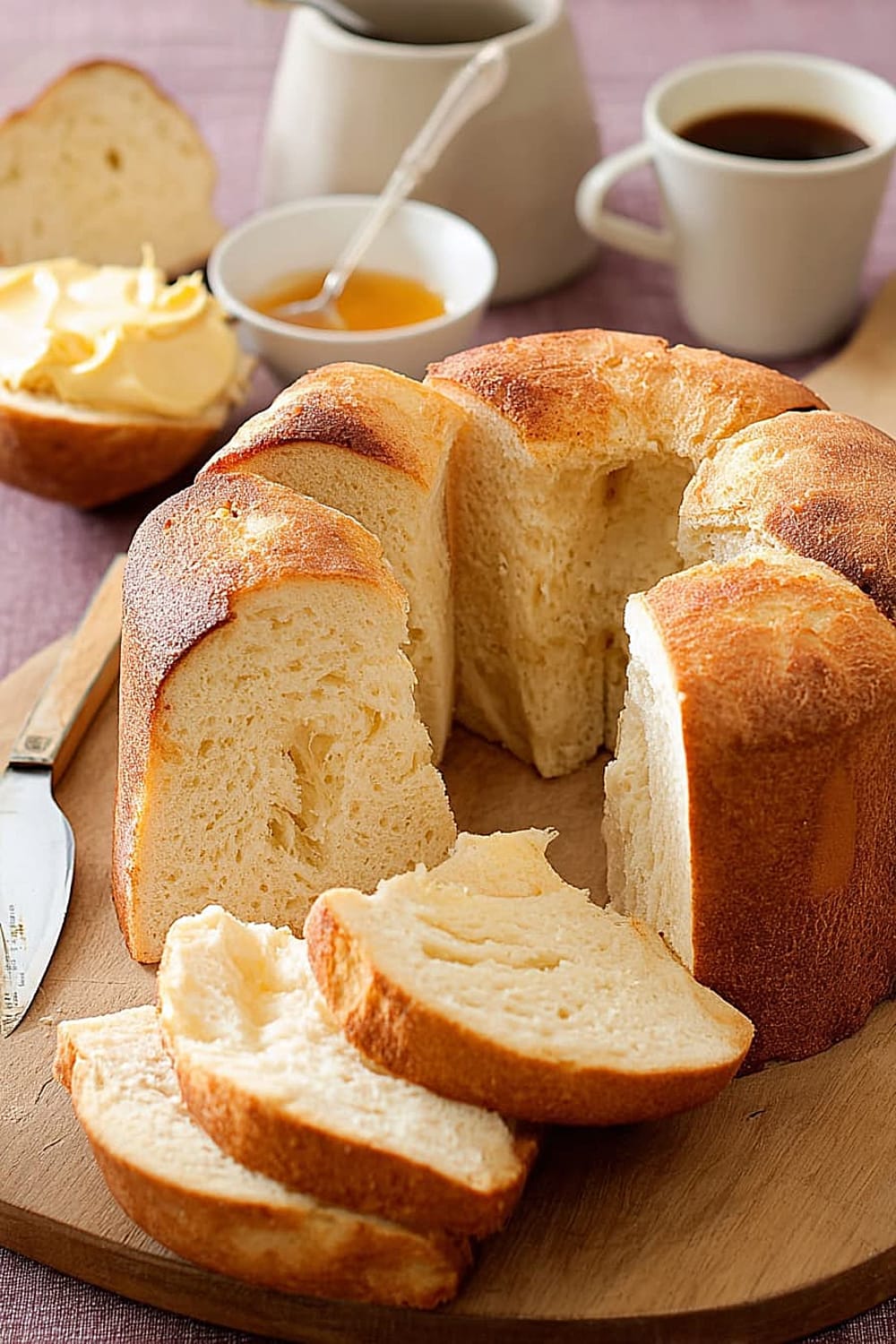
Nutritional Information and Health Benefits
Key Nutritional Highlights:
Each serving of this Sally Lunn bread provides approximately 285 calories, with the rich combination of eggs, milk, and butter contributing high-quality protein and essential fats. The 3 large eggs provide complete protein containing all essential amino acids, while the 1 cup milk adds calcium, vitamin D, and riboflavin. The all-purpose flour contributes B vitamins, particularly thiamine and niacin, which support energy metabolism and nervous system function.
Health Benefits of Main Ingredients:
The active dry yeast not only creates the bread’s lovely rise but also provides B vitamins, particularly folate and B12, which support cellular function and energy production. Eggs are nutritional powerhouses, offering choline for brain health, selenium for antioxidant protection, and lutein for eye health. The milk provides high-quality protein and calcium essential for bone health, while the natural enzymes support digestive health. Butter, while calorie-dense, provides fat-soluble vitamins A, D, E, and K, plus conjugated linoleic acid when sourced from grass-fed cows.
Dietary Considerations:
This bread contains gluten, dairy, and eggs, making it unsuitable for those with celiac disease, lactose intolerance, or egg allergies without modifications. Each generous serving provides about 45 grams of carbohydrates, making portion control important for blood sugar management. The rich nature of Sally Lunn bread makes it perfect for special occasions rather than daily consumption, and pairing it with protein can help moderate blood sugar response.
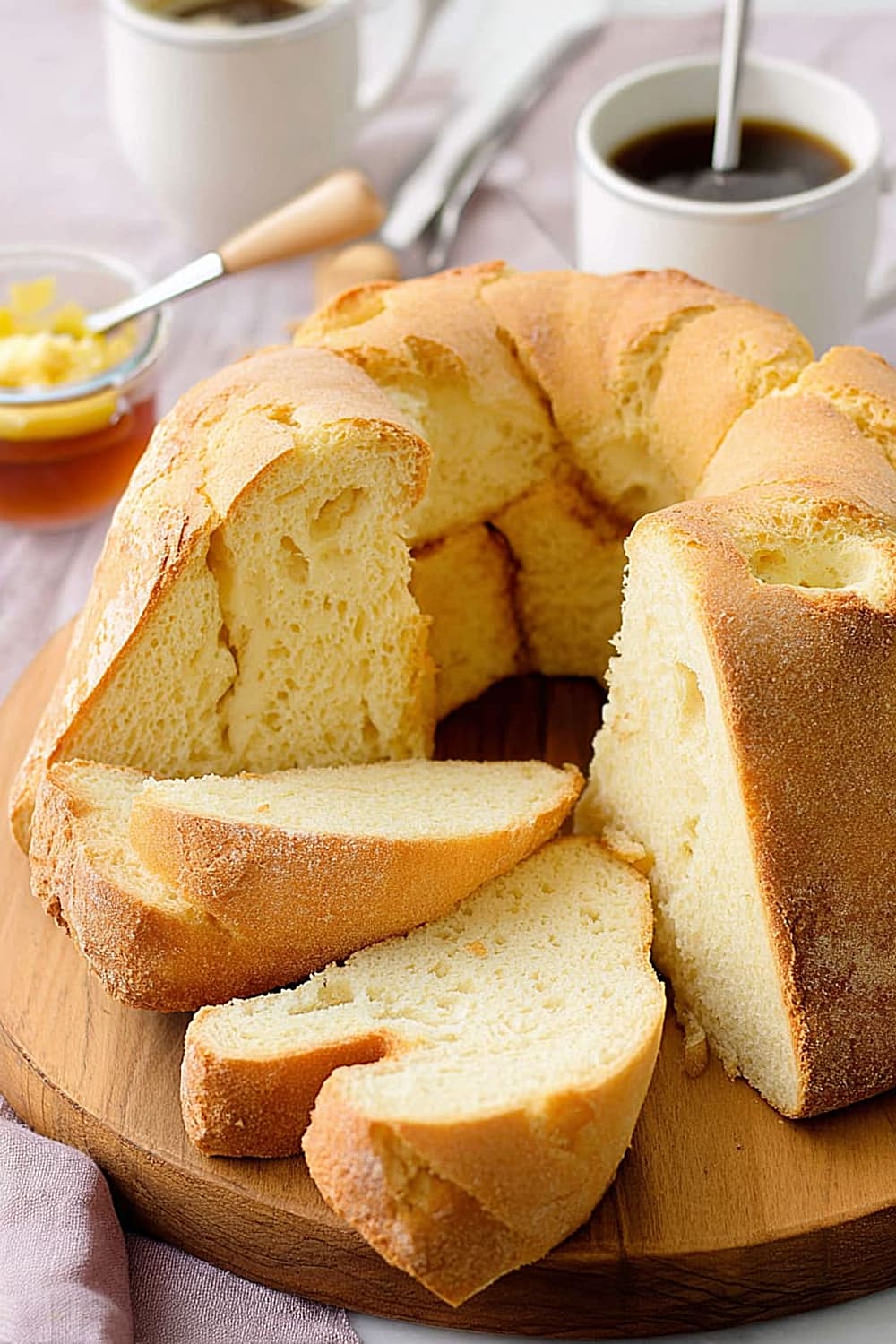
Smart Swaps and Ingredient Substitutions
Common Substitutions:
- All-purpose flour → Bread flour (use same amount for chewier texture) or whole wheat pastry flour (substitute up to half for added fiber)
- 2% milk → Whole milk for richer flavor, buttermilk for tangier taste (reduce salt by 1/2 teaspoon), or heavy cream mixed with water for ultra-rich version
- Granulated sugar → Brown sugar for deeper molasses notes, coconut sugar for subtle caramel flavor, or maple syrup (reduce liquid by 2 tablespoons)
- Butter → Coconut oil (solid state) for dairy-free option, or high-quality margarine for lighter texture
Budget-Friendly Swaps:
- Large eggs → Medium eggs (use 4 instead of 3) or egg substitute equivalent to 3 eggs
- Honey in honey butter → Maple syrup, agave nectar, or corn syrup for similar consistency and sweetness
- Active dry yeast → Instant yeast (use same amount, no need to dissolve first)
Pantry Emergency Substitutions:
- Warm milk → Powdered milk reconstituted with warm water (use 1/3 cup powder + 1 cup warm water)
- Fresh eggs → Applesauce (1/4 cup per egg) for binding, though texture will be slightly different
- Softened butter → Vegetable oil (use 3/4 the amount) for emergency situations, though flavor will be milder
Pro Tips for Substitutions:
- Store active dry yeast in the refrigerator after opening and check expiration dates for best rising power
- When substituting whole grain flours, add extra liquid gradually as they absorb more moisture than white flour
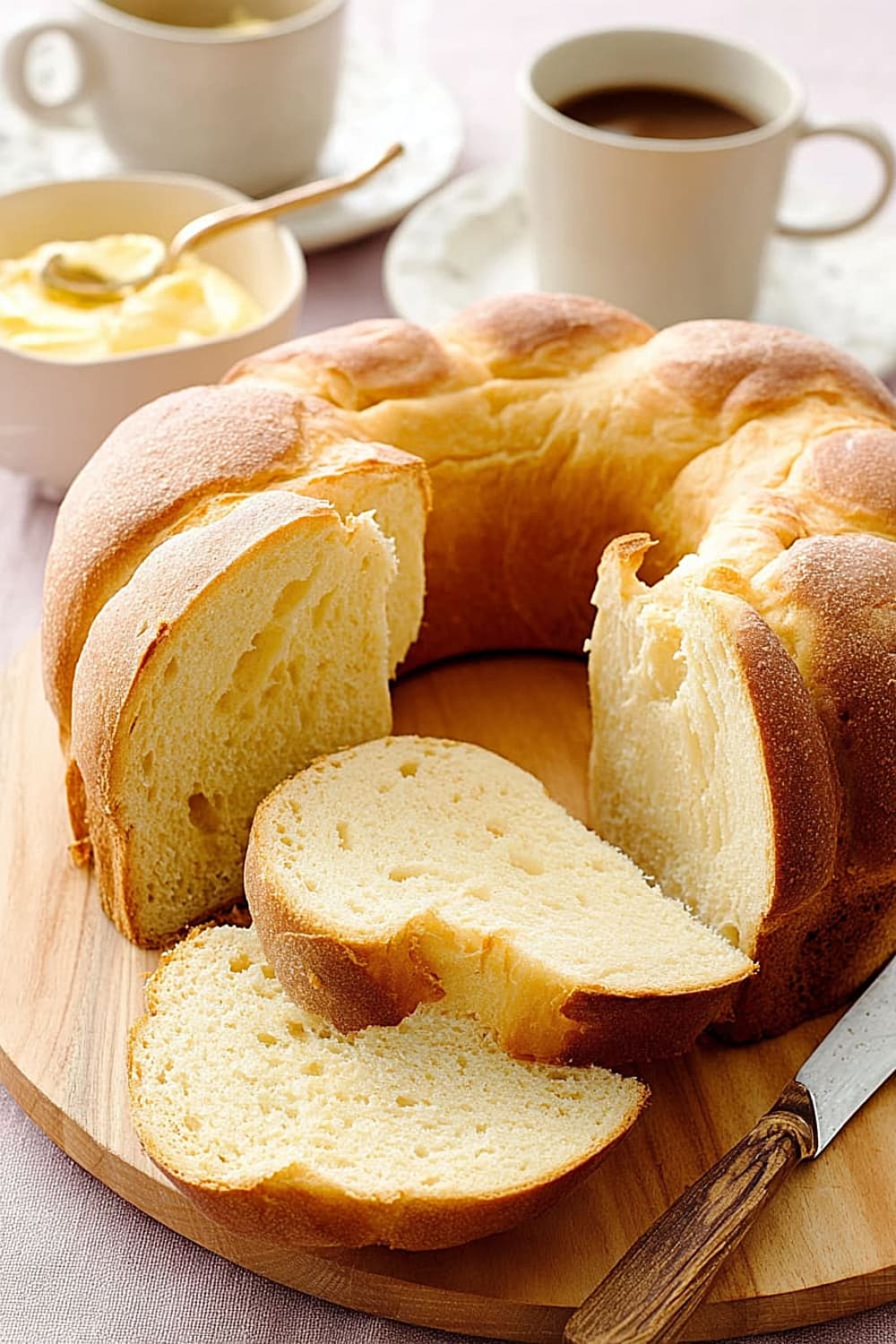
Make It Diabetes-Friendly
Sugar Substitutions:
- Replace the 1/4 cup granulated sugar with 2 tablespoons erythritol or 3 tablespoons stevia-erythritol blend to reduce carbs by approximately 45 grams per entire recipe
- For the honey butter, substitute 1/2 cup honey with 1/4 cup sugar-free honey alternative or 2 tablespoons powdered erythritol mixed with 1/4 cup butter for a 60-gram carb reduction
Flour & Carb Modifications:
- Replace 2-3 cups of the all-purpose flour with almond flour or coconut flour (use 1/4 the amount if using coconut flour and add extra liquid)
- Try substituting half the flour with whole wheat pastry flour for added fiber and slower glucose absorption
- Consider using oat fiber for up to 1 cup of flour to significantly reduce net carbs
Portion & Timing Tips:
- Cut into 20 smaller servings instead of 16 to reduce carb content to approximately 25 grams per piece
- Pair each serving with 2 tablespoons nuts or 1 ounce cheese to slow glucose absorption
- Serve alongside protein-rich foods like eggs or Greek yogurt when enjoying for breakfast
Total Carb Reduction: These modifications can reduce total carbs by 35-50% while maintaining the beloved Sally Lunn texture and flavor profile.
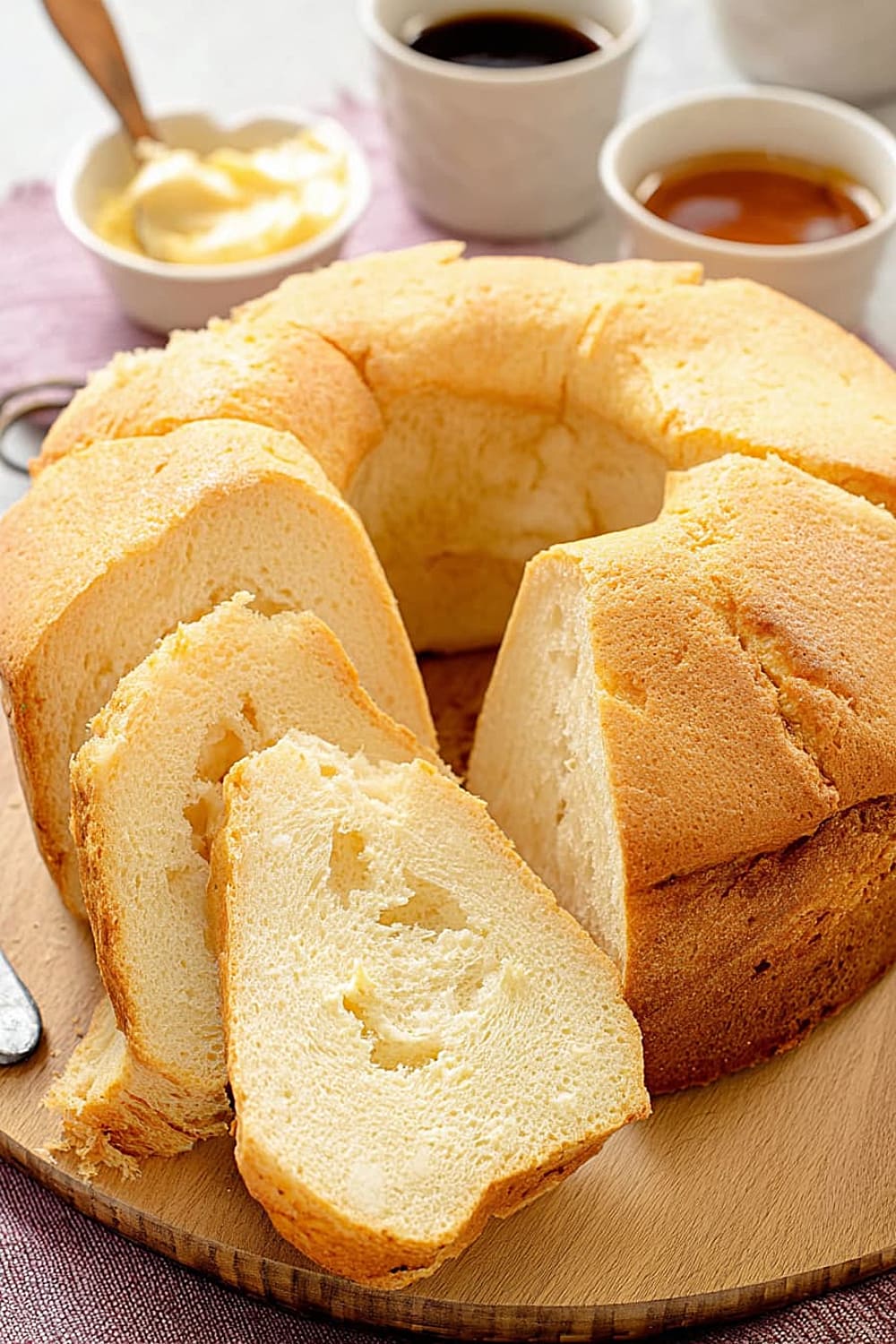
Perfect Pairing Suggestions
Beverage Pairings:
This rich, buttery bread pairs beautifully with Earl Grey or English Breakfast tea, whose robust flavors complement the bread’s subtle sweetness without overwhelming it. For coffee lovers, a medium roast coffee or café au lait creates a perfect breakfast combination. During special occasions, champagne or prosecco makes an elegant pairing for brunch, while sweet dessert wines like Moscato enhance the bread’s natural sweetness for afternoon tea service.
Side Dish Recommendations:
Sally Lunn bread shines alongside fresh seasonal fruit – try sliced strawberries, peaches, or pears that contrast beautifully with the rich, buttery texture. Scrambled eggs with fresh herbs create a complete brunch experience, while thick-cut bacon or breakfast sausage provides savory balance. For afternoon tea service, pair with cucumber sandwiches, smoked salmon, or aged cheeses like sharp cheddar or creamy brie that complement the bread’s subtle sweetness.
Complete Meal Ideas:
Build an impressive English-style afternoon tea featuring Sally Lunn bread as the centerpiece, accompanied by finger sandwiches, scones, and delicate pastries. For holiday brunches, serve alongside eggs Benedict, fresh fruit salad, and crispy hash browns. The bread also makes an excellent base for French toast when slightly stale, creating an ultra-rich breakfast treat that’s perfect for special occasions.
Occasion Suggestions:
This bread is ideal for Easter brunch, Christmas morning, baby showers, and wedding brunches where its elegant appearance and rich flavor make lasting impressions. The beautiful golden color and distinctive shape make it perfect for photography-worthy gatherings and special celebrations that call for something beyond ordinary bread.
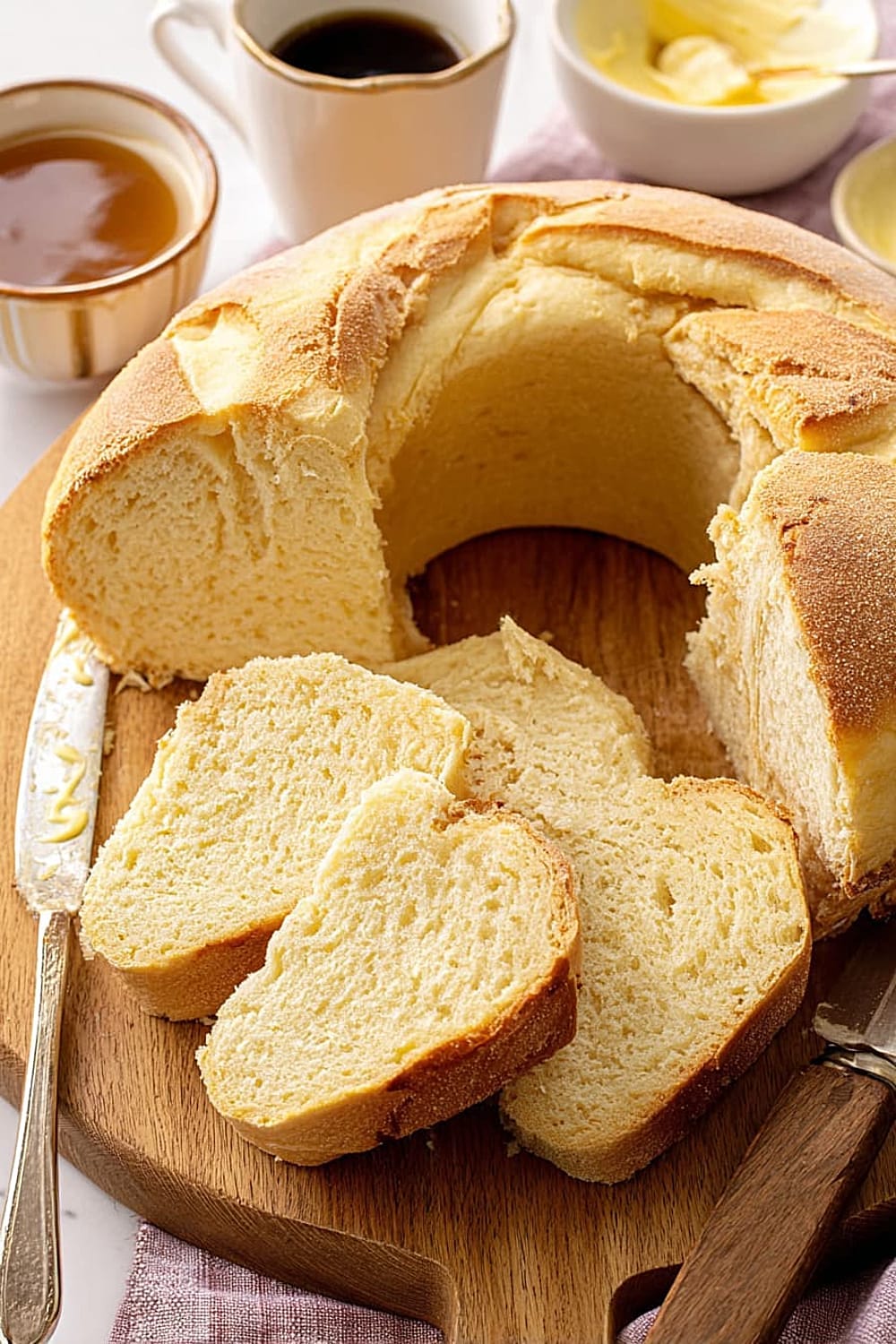
Pro Tips and Troubleshooting
Professional Baking Secrets:
The key to perfect Sally Lunn bread lies in temperature control – always use an instant-read thermometer to ensure your liquids are exactly 110-115°F for optimal yeast activation. Room temperature eggs incorporate much more easily than cold ones; if you forget to bring them to room temperature, place them in a bowl of warm water for 10 minutes. When checking if your dough has doubled, use the poke test – gently press two fingers into the dough, and if the indentation remains, it’s perfectly risen.
Common Mistake Prevention:
Never rush the rising process, even if your kitchen is cool – good bread takes time. If your kitchen is particularly cold, create a warm environment by turning your oven to 200°F for 2 minutes, then turning it off and placing the covered bowl inside. Over-flouring is the enemy of Sally Lunn’s tender texture, so add flour gradually and stop when the dough just pulls away from bowl sides while remaining soft and slightly sticky.
Storage and Make-Ahead Strategies:
Fresh Sally Lunn bread stays perfect for 3 days wrapped in plastic wrap at room temperature, or freeze whole or sliced for up to 3 months. The honey butter can be made 1 week ahead and stored covered at room temperature. For make-ahead convenience, prepare the dough through the first rise, then refrigerate overnight and continue with shaping and second rise the next day – this actually improves the flavor development.
Scaling and Presentation:
This recipe doubles beautifully for large gatherings – just use two tube pans and extend baking time by 5 minutes. For elegant presentation, dust with powdered sugar just before serving, or create a simple lemon glaze with powdered sugar and fresh lemon juice for special occasions.
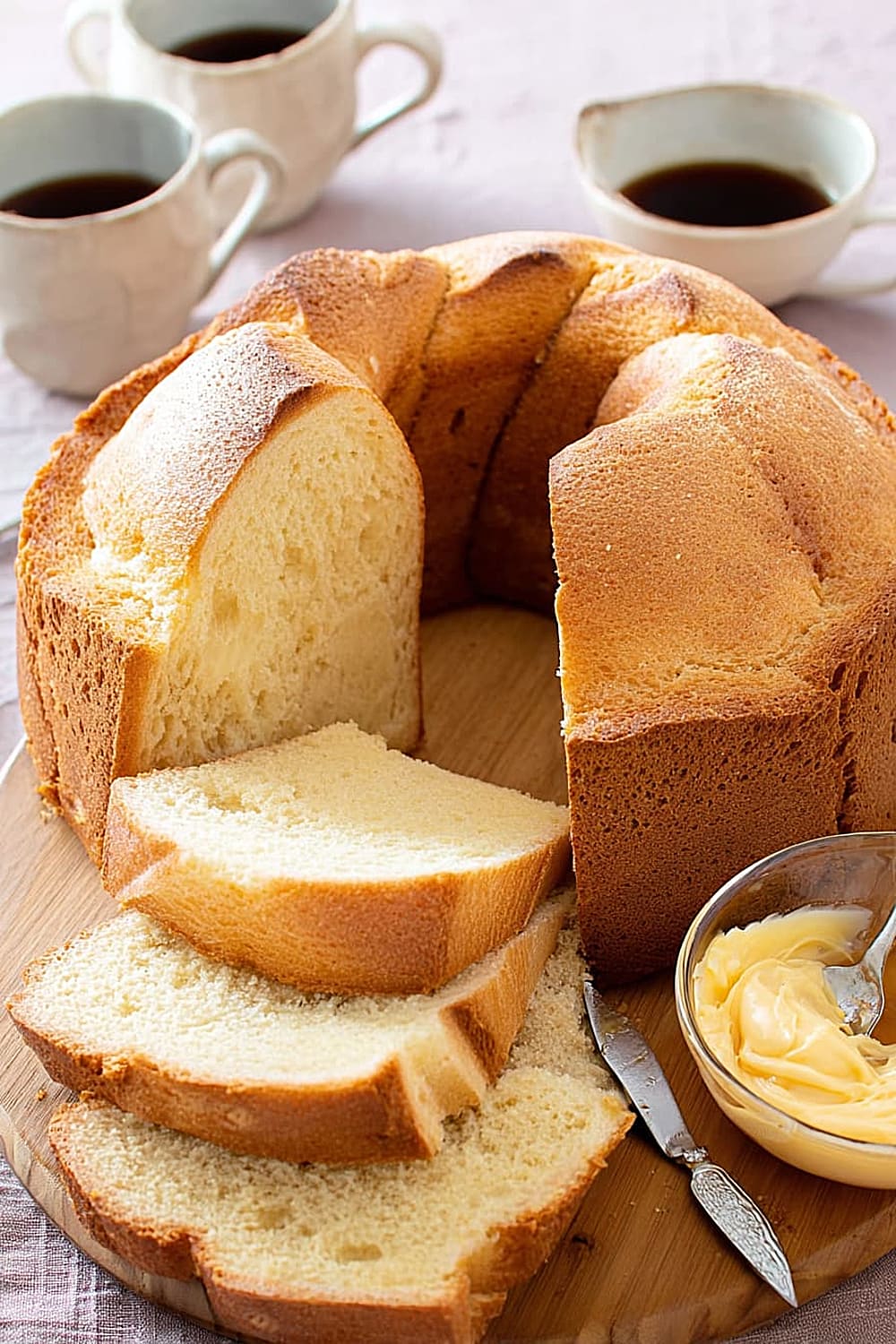
There’s something truly magical about sharing a loaf of homemade Sally Lunn bread with the people you love. This isn’t just bread – it’s a connection to centuries of baking tradition, a centerpiece that transforms ordinary moments into cherished memories, and proof that some of life’s greatest pleasures come from the simplest ingredients combined with a little patience and care. Whether you’re starting a new family tradition or adding something special to your baking repertoire, this golden, buttery masterpiece will have everyone asking for the recipe and coming back for seconds.